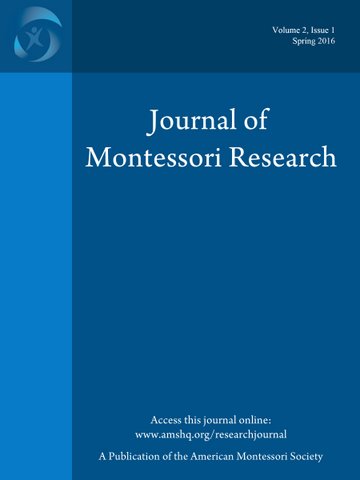An Intervention Study: Removing Supplemented Materials from Montessori Classrooms Associated with Better Child Outcomes
DOI:
https://doi.org/10.17161/jomr.v2i1.5678Palavras-chave:
Montessori, early childhood educationResumo
Montessori classrooms vary a good deal in implementation, and one way in which implementation differs is the provision of materials. Specifically, some classrooms use only Montessori materials, whereas others supplement the Montessori materials with commercially available materials like puzzles and games. A prior study suggested this might be a reason for observed differences across studies and classrooms (Author, 2012) but an intervention study is the best test. The present study presents such an intervention with 52 children in 3 Montessori classrooms with Supplementary materials. All children were given 6 pretests, and non-Montessori materials were removed from 2 of the classrooms. Four months later, children were retested to see how much they changed across that period. Children in the classrooms from which the non-Montessori materials were removed advanced significantly more in early reading and executive function, and to some degree advanced more in early math. There were no differences across the classroom types in amount of change on the tests of vocabulary, social knowledge, or social skills.
Referências
Ansari, A., & Winsler, A. (2014). Montessori public school pre-K programs and the school readiness of low-income Black and Latino children. Journal of Educational Psychology, 106, 1066-1079. doi: 10.1037/a0036799
Besancon, M., & Lubart, T. (2008). Differences in the development of creative competencies in children schooled in diverse learning environments. Learning and Individual Differences, 18, 381-389. doi: 10.1016/j.lindif.2007.11.009
Blachowicz, C. L., Fisher, P. J., Ogle, D., & Wattes-Taffe, S. (2006). Vocabulary: Questions from the classroom. Reading Research Quarterly, 41, 524-539.
Brown, K. E., & Steele, A. S. (2015). Racial discipline disproportionality in Montessori and traditional public schools: A comparative study using the relative rate index. Journal of Montessori Research, 1, 14-27.
Cox, M. V., & Rowlands, A. (2000). The effect of three different educational approaches on children's drawing ability: Steiner, Montessori and traditional. British Journal of Educational Psychology, 70, 485-503.
Dohrmann, K. R., Nishida, T. K., Gartner, A., Lipsky, D. K., & Grimm, K. J. (2007). High school outcomes for students in a public Montessori program. Journal of Research in Childhood Education, 22, 205-217.
Krafft, K. C., & Berk, L. E. (1998). Private speech in two preschools: Significance of open-ended activities and make-believe play for verbal self-regulation. Early Childhood Research Quarterly, 13, 637-658.
Lillard, A. S., & Else-Quest, N. (2006). Evaluating Montessori education. Science, 313, 1893-1894. doi: 10.1126/science.1132362
Lillard, A. S. (2011). Materials: What belongs in a Montessori primary classroom? Results from a survey of AMI and AMS teacher trainers. Montessori Life, 22, 18-32.
Lillard, A. S. (2012). Preschool children's development in classic Montessori, supplemented Montessori, and conventional programs. Journal of School Psychology, 50, 379-401. doi: 10.1016/j.jsp.2012.01.001
Lopata, C., Wallace, N. V., & Finn, K. V. (2005). Comparison of academic achievement between Montessori and traditional education programs. Journal of Research in Childhood Education, 20, 5-13.
Miller, L. B., & Bizzell, R. P. (1984). Long-term effects of four preschool programs: Ninth- and tenth-grade results. Child Development, 55, 1570-1587.
Montessori, M. (1956). The child in the family (N. R. Cirillo, Trans.). New York: Avon.
Montessori, M. (1966). The secret of childhood (M. J. Costello, Trans.). New York: Ballantine.
Montessori, M. (1994). Creative development in the child Vol 1 (R. Ramachandran, Trans.). Madras, India: Kalakshetra Press.
Ponitz, C. C., McClelland, M. M., Jewkes, A. M., Connor, C. M., Farris, C. L., & Morrison, F. J. (2008). Touch your toes! Developing a direct measure of behavioral regulation in early childhood. Early Childhood Research Quarterly, 23, 141-158. doi: 10.1016/j.ecresq.2007.01.004
Ponitz, C. C., McClelland, M. M., Matthews, J. S., & Morrison, F. J. (2009). A structured observation of behavioral self-regulation and its contribution to kindergarten outcomes. Developmental Psychology, 45, 605-619. doi: 10.1037/a0015365
Rathunde, K. R., & Csikszentmihalyi, M. (2005a). Middle school students’ motivation and quality of experience: A comparison of Montessori and traditional school environments. American Journal of Education, 111, 341-371.
Rathunde, K. R., & Csikszentmihalyi, M. (2005b). The social context of middle school: Teachers, friends, and activities in Montessori and traditional school environments. Elementary School Journal, 106, 59-79.
Rodriguez, L., Irby, B. J., Brown, G., Lara-Alecio, R., & Galloway, M. M. (2005). An analysis of second grade reading achievement related to pre-kindergarten Montessori and transitional bilingual education. In V. Gonzalez & J. Tinajero (Eds.), Review of research and practice (Vol. 3, pp. 45-65). Mahwah, NJ: Lawrence Erlbaum.
Rubin, K. H. (1988). The social problem-solving test-revised. University of Waterloo. Waterloo, Ontario.
Wellman, H. M., & Liu, D. (2004). Scaling of theory-of-mind tasks. Child Development, 75, 523-541.
Woodcock, R. W., McGrew, K. S., & Mather, N. (2001). Woodcock-johnson iii tests of achievement. Rolling Meadows, IL: Riverside Publishing.


